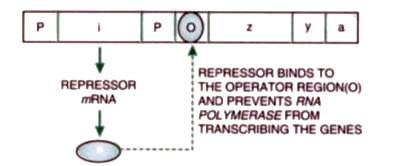Complete Solutions to PRACTICE QUESTIONS ( LONG ANSWER TYPE QUESTIONS ) of chapter MOLECULAR BASIS OF INHERITANCE of Class 12 book with complete answers and questions
| Class 12 | BIOLOGY |
| Chapter | MOLECULAR BASIS OF INHERITANCE |
| SRIJAN | PRACTICE QUESTIONS ( LONG ANSWER TYPE QUESTIONS ) |
| Number Of Questions | 25 |
| Academic Year | 2023-24 |
Describe the salient features of the double helical model of DNA.
06:11View SolutionExplain the process of DNA replication.
07:19View SolutionWhat is reverse transcription? Explain how single-stranded RNA of viruses give rise to double-stranded DNA?
03:34View SolutionOne chromosome contains one molecule of DNA. In eukaryotes the length of the DNA molecule is enormously large. Explain how such a long molecule fits into the tiny chromosomes seen at Metaphase.
05:55View Solution(a) Explain the role of regulatory gene, operator and structural genes in lac operon when E. Coli is growing in a culture medium with the sources of energy as lactose.
05:51View SolutionGenetic material is DNA and not protein. How did Griffith prove this?
06:32View SolutionGive any six features of the humen genome.
08:24View SolutionWhat are the advantages and probable risks of genetic engineering?
04:08View SolutionWhat are retroviruses? How do they modify the central dogma in molecular biology?
04:23View SolutionWhat are three types of RNA molecules which perform different functions?
02:13View SolutionWhich one of these has the shape of a clover leaf in two dimensional structure?
05:23View SolutionHow is each RNA related in the information flow during protein synthesis? Explain.
02:53View Solution(a) State the arrangement of different genes that in bacteria is referred to as operon.
(b) Describe the role of lactose in lac operon.
(c) Draw a schematic labelled illustratiomof lac operon in a switched on state.02:32View Solution(a) State the arrangement of different genes that in bacteria is referred to as operon.
(b) Describe the role of lactose in lac operon.
(c) Draw a schematic labelled illustratiomof lac operon in a switched on state.02:32View SolutionHow was bacterial transformation proved experimentally? Who has performed this experiment?
04:38View SolutionWho performed ‘Blender experiment’ with respect to DNA? What was the objective of this experiment? Explain the procedure in detail.
06:52View SolutionWhere do transcription and translation occur inside a living cell? Briefly describe the three steps involved in the process of translation.
04:49View SolutionIllustrated below is a DNA segment, which constitutes a gene.

Explain how do these genes express?03:17View SolutionIllustrated below is a DNA segment, which constitutes a gene.

Name the shaded and unshaded parts of the gene.00:52View SolutionIllustrated below is a DNA segment, which constitutes a gene.

Explain how do these genes express?03:17View SolutionIllustrated below is a DNA segment, which constitutes a gene.

How is this gene different from prokaryotic gene in its expression?02:36View SolutionLook at the figure depicting lac operon of E. coli.

What could be the series of events when an inducer is present in the medium in which E. coli is growing?02:15View SolutionLook at the figure depicting lac operon of E. coli.

Name the inducer.02:12View SolutionDescribe how the lac operon operates, both in the presence and absence of an inducer in E. coli.
05:19View SolutionHow are the structural genes inactivated / activated in lac operon in E. coli? Explain.
03:37View Solution
PRACTICE QUESTIONS ( LONG ANSWER TYPE QUESTIONS ) questions and complete solutions for chapter MOLECULAR BASIS OF INHERITANCE of SRIJAN BIOLOGY (ENGLISH) of Class 12
All Exercises from SRIJAN Class 12 BIOLOGY MOLECULAR BASIS OF INHERITANCE
- ILLUSTRATIVE QUESTIONS
- MCQ
- MCQ (Assertion and Reason)
- MCQ (Choose the odd one out of the following)
- MCQ (Figure based questions)
- MCQ (Fill in the blanks)
- MCQ (Match the following)
- MCQ (Source Based Questions)
- OBJECTIVE TYPE QUESTIONS (ASSERTION AND REASON TYPE QUESTION )
- OBJECTIVE TYPE QUESTIONS (MULTIPLE CHOICE QUESTION (MCQ)
- PRACTICE QUESTIONS ( LONG ANSWER TYPE QUESTIONS )
- PRACTICE QUESTIONS (SHORT ANSWER TYPE -II)
- PRACTICE QUESTIONS (SHORT ANSWER TYPE)
- PRACTICE QUESTIONS (VERY SHORT ANSWER TYPE QUESTIONS
- PREVIOUS YEARS BOARD PAPER QUESTIONS ( LONG ANSWER TYPE QUESTIONS)
- PREVIOUS YEARS BOARD PAPER QUESTIONS ( SHORT ANSWER TYPE-II)
- PREVIOUS YEARS BOARD PAPER QUESTIONS ( VERY SHORT ANSWER TYPE QUESTIONS)
- REVIEW QUESTIONS
